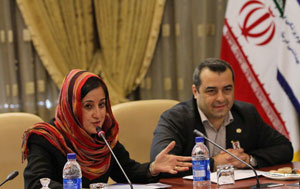U.S. relations with Iran may be strained on the diplomatic front but scientific engagement between the two countries is flourishing. Attendees at a recent meeting in Tehran identified a number of promising areas for collaboration.
Several Americans traveled to Iran for the country's first international and fifth annual HIV/AIDS conference. Also among the 300 participants were representatives from Afghanistan, Bulgaria, Holland, Kenya, Nigeria, Sweden and the UK.
Co-organized by UNAIDS and the Iranian Research Center for HIV/AIDS - part of Tehran University Medical School - the proceedings were conducted in English. Topics ranged from the prevention of maternal-to-child transmission, to harm reduction through examination of transmission routes, to strategies to strengthen Iran's overall response to HIV/AIDS.

Photo courtesy of Tehran University of Medical Sciences
Iranian-born Harvard scientist Dr. Navid Madani (left),
an NIH grantee, helped organize Iran's first
international and fifth annual HIV/AIDS conference.
Iranian-born Harvard scientist Dr. Navid Madani helped organize the symposium. An NIH grantee, she said she found a warm response from the host scientific community. "Iranians place a high value on establishing international scientific collaborations and in building research capacity in their country," Madani noted.
Indeed, there are a number of longstanding research collaborations between NIH and NIH-funded researchers and their Iranian counterparts on topics including cancer, hepatitis and opiate addiction. While these types of partnerships require a license from the Office of Foreign Assets Control at the U.S. Treasury Department, obtaining one is not onerous and the benefits can be enormous, according to Fogarty's Middle East officer Judy Levin.
In the case of the HIV/AIDS, Iran's approach provides a useful model, Madani suggested. "Iran can be the beacon for all the countries around it." Iranian health officials have taken measures to decrease both the HIV infection rate and the disease's stigma, she said. In addition, they offer free condoms, voluntary testing and include prison inmates in their outreach. "We can learn so much from Iran and its grassroots model of health houses in each village, not just to benefit our primary health care but also our approach to HIV prevention and care," said Madani.
The country's latest strategic plan to combat HIV/AIDS acknowledged the virus is increasingly spread through sexual contact. With more than 24,000 Iranians testing positive for HIV - the vast majority male - this was a critical breakthrough, Madani observed.
The idea for the conference grew from a workshop focused on the Middle East and North Africa region held at the 2010 international AIDS meeting in Vienna, with support from the NIH Office of AIDS Research. The connections made then were strengthened in Tehran.
"The scientific interactions were quite positive," Madani observed, "In addition to this stimulating scientific dialogue, we had an absolute gold mine of people understanding each other and a unique cultural and scientific exchange." The positive response may lead to additional international scientific gatherings in Iran, a possible faculty exchange program between U.S. and Iranian institutions, as well as enhanced research collaborations.
More Information